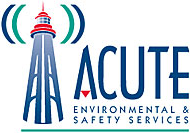Employers must meet a number of health and safety training requirements mandated by the provincial government of Ontario’s Occupational Health and Safety Act (OHSA). Click here to see upcoming ACUTE training and how our trainers and courses help you meet standards, build competence, and demonstrate due diligence. The best way to ensure compliance is to get the best hands-on training for employees and also ensure your trainer helps your team build skills to help demonstrate due diligence without hampering efficiency. Using the Ministry of Labour, Immigration, Training and Skills Development’s (MLITSD) Health and Safety Checklist, we identify the key questions and parameters to gauge how well your organization is adhering to regulations.
Here is a quick clip from the Ontario Government to help your staff understand that workplace safety is everyone’s job.
Health and Safety Checklist
Depending on the size of an organization there are different sets of regulatory requirements. The checklist differs based on the number of employees within an organization and is organized in these three brackets: 1-5 , 6-19, and 20 or more employees. Below is a summary of a check-list for a small business owner of 1-5 employees. If your organization falls into another bracket click here for the full checklist.
To use this checklist, answer yes or no to each of the questions and then address the gaps that have been identified for each item you answered with “no.”
Roles and Responsibilities
- Is the OHSA “Prevention Starts Here” poster and resource material posted in your workplace?
- Is the material provided in English and in the most applicable language for your staff?
- Are you aware of the duties and responsibilities under OHSA as an employer?
- Are other stakeholders within your organization aware of their roles within the OHSA (Supervisors, Workers, Directors, Constructor, and Owner)?
- Are there supervisors that:
-Are knowledgeable about health and safety legislation?
-Have experience training and managing workers?
-Have knowledge of the possible and actual hazards with the work? - Is your organization aware that discipline cannot be applied to workers acting on the guidelines of the OHSA?
 Here is what a recent customer had to say about their experience engaging ACUTE as their training provider:
Here is what a recent customer had to say about their experience engaging ACUTE as their training provider:
“Very professional approach to consulting. I am not surprised about the success ACUTE has achieved over the last 15 years that I have worked with them. ACUTE delivers with great customer service (creative solutions, flexible accommodation, professional conduct). ACUTE is recognized and respected as a people organization and they have been doing it right for a long time.“
–Konstantinos
See here for more reviews.
Reporting and Records Management
- Do you encourage staff to report hazards or violations in the workplace?
- Are actions taken to address hazards or violations documented?
- Does your organization know how to report deaths, injuries, and occupational illnesses to the MLITSD?
- Are you aware that a MLITSD inspector may audit your workplace at any time?
- Are you aware that you must comply with an MLITSD inspector’s orders within the timeframe provided?
- Field reports issued by a MLITSD Inspector must be posted in a highly visible place within your workplace?
Hazards in the Workplace
- For each type of work performed, have you determined the safety hazards in your workplace?
- Has staff been informed of the hazards they may be exposed to in the workplace?
- Are there mechanisms and procedures to manage these hazards?
- Is staff interacting with, or close to, hazardous materials?
- Are there measures to control these hazardous substances?
Instructions and Training
- Have your supervisors and staff completed required health and safety training?
- Do your organization and supervisors provide staff with workplace-specific training on known hazards?
- Are staff informed and trained on how to prevent workplace violence and harassment?
- Has information, instructions, and supervision been provided to staff to protect their health and safety?
 Planning for Compliance and Due Diligence
Planning for Compliance and Due Diligence
Creating a health and safety policy is a great way to plan towards being an effective and safe workplace. The MLITSD provides resources to help organizations get started on a policy. The Ministry suggest also that a policy is accompanied by a program (resources, process, and governance) to ensure health and safety is a priority within an organization. MLITSD suggests 17 dimensions to any successful health and safety program within an organization and we’ve picked out ones that organizations typically need to focus more on:
- Worker training (e.g., new workers, WHMIS, new job procedures)
- Analysis of the accidents and illnesses occurring in the workplace
- A health and safety budget
- A formal means of communication to address the concerns of workers promptly
- Confined space entry procedures
- Lockout procedures
- Emergency and rescue procedures
 Why Training Makes All the Difference
Why Training Makes All the Difference
Training helps translate policy into best practices and learned habits that not only pay dividends for the individual but for the organization as a whole. Further qualified training must also meet OHSA requirements. A previous article highlights how regulatory requirements are met by a number of ACUTE training courses.
The table below summarizes the key regulatory requirements and courses provided to help your staff get the best hands-on training at our industry leading facilities or at the convenience of your workplace. Contact us here to find out.
[table id=2 /]
Going Beyond Compliance with ACUTE’s Ontario Health and Safety Training
Meeting regulatory requirements offers significant accountability for employers. The true objective, however, is to ensure workers are effectively protected and equipped to navigate workplace hazards. ACUTE not only meets government requirements but strives to provide quality, hands-on, and industry-tailored training to each of their clients. ACUTE has a cutting-edge training facility that has hosted the Ontario Ministry of Defense and Labour. Here are ways that ACUTE goes beyond government compliance in Ontario health and safety training.
- Open Door Instructor-Student Partnersh
 ip: ACUTE’s training services emphasize client participation. Staff foster relationships with clients and serve as a touchstone for advice moving forward.
ip: ACUTE’s training services emphasize client participation. Staff foster relationships with clients and serve as a touchstone for advice moving forward. - Serving Your Team and Industry: With a vast array of clients in the manufacturing, construction, health, academic, and government sectors, ACUTE brings the best safety practices from across the spectrum to your workplace.
- 100 Years Combined Experience: ACUTE provides comprehensive health and safety training, on-site safety services, and consulting services. With over 100 years of combined experience, our staff offers more than theoretical or abstract ideas. ACUTE offers solutions.
- Track Record of Success: ACUTE is rated 4.9/5 stars on Google reviews, demonstrating a commitment to our clients, quality, and a passion for training.
Contact us today for quality training in your workplace or on-site at ACUTE’s proven training facilities!
ACUTE is located in Waterloo, Ontario, and services customers from cities such as Toronto, Mississauga, Brampton, Hamilton, Milton, Kitchener, London, and Guelph as well as a large list of other cities from across Ontario.
Sources:
https://www.ontario.ca/laws/statute/90o01?_ga=1.220707416.1314123899.1460396938#BK40
http://www.labour.gov.on.ca/english/hs/pubs/ohsa/ohsag_appx_a.php
http://www.forms.ssb.gov.on.ca/mbs/ssb/forms/ssbforms.nsf/FormDetail?OpenForm&ACT=RDR&TAB=PROFILE&SRCH=&ENV=WWE&TIT=1960&NO=1960E

